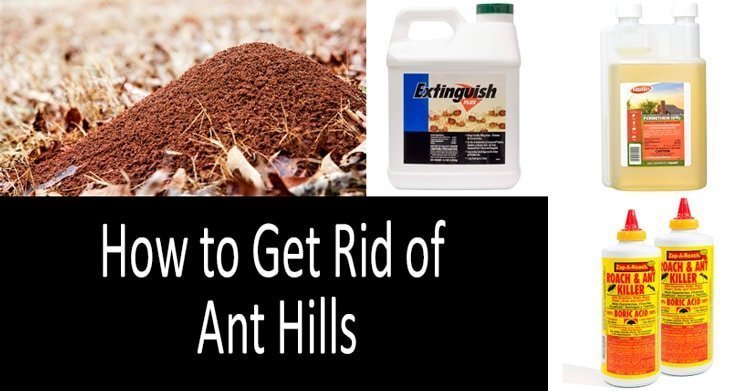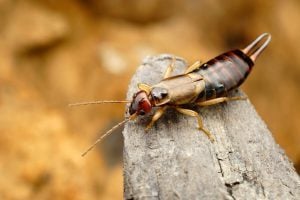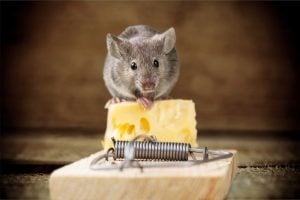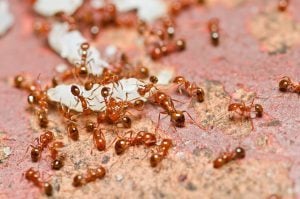What is the best way to get rid of ant hills? While baits is a good slow-acting solution, they do not work against ant colonies located deep underground. Nor are they effective when applied to the wet soil and in the rainy weather. This is what makes liquid insecticides a universal solution as they can be used as an ant mound drench. All you need to do is to dig channels into the nest and pour the stuff on. This the surest way to kill the queen and other members of the colony!
When looking for a liquid insecticide, make sure that it can be safely applied around grazing animals and is based on active ingredients that work against ants, such as Permethrin, Bifenthrin or Deltamethrin. We believe that Martin’s Permethrin 10% Multi-Purpose Insecticide fits these criteria best.
{top_pick type=”other” title=”Martin’s Permethrin” image_url=”https://m.media-amazon.com/images/I/41oTZkVZSEL._SL160_.jpg” link=”https://www.amazon.com/Martins-Permethrin-Indoor-Outdoor-Use-Pint/dp/B0076PYA6C?&linkCode=ll1&tag=stoppestinfo0-20&linkId=c90443a9b3fb16279f016d49eb55f235&language=en_US&ref_=as_li_ss_tl”}Why have we chosen it? The Martin’s brand was established in 1904 and since then has gained a reputation for the excellent quality of its lawn and garden products. Based on Permethrin, this highly concentrated insecticide is recommended by scientists as an ant mound drench. It provides a quick knockdown effect and has a long-lasting residue. Not only does it eradicate the entire colony and kill the queen but it also prevents new ants from settling in the abandoned nest. You can safely apply the solution in the areas where your livestock graze. Also, the insecticide is almost odorless and easy to use.{/top_pick}
What You Will Learn from This Guide:
Why Target the Entire Colony, Not Individual Ants?
Anthills are a typical problems in lawns and backyards as they destroy the aesthetic or sometimes hinder mowing. While being common nuisance pests, ants are not easy to control in large part because of their high numbers. Ants live in colonies — the basic unit around which they organize. The pivot of any colony is one or more queens, the largest ants that lay eggs and can establish new colonies. Other members of the colony are wingless workers which are engaged in feeding the larvae and the queen, cleaning or expanding the tunnels, foraging for food and defending the colony.
The organizational structure of ant society is really impressive and even exceptional. It boasts perfect self-organization, with each individual insect fully dedicates its life to the interests of the community. While an individual ant isn’t very smart, ants acting as a collective can do amazing things.
“A colony is analogous to a brain where there are lots of neurons, each of which can only do something very simple, but together the whole brain can think,” said Deborah M. Gordon, assistant professor of biology at Stanford University. They communicate using chemicals and each member of the colony has its prescribed task — housekeeping, foraging, patrolling. However, an ant may switch to another task if the colony needs it. For example, when a new source of food is discovered, an ant engaged in hill maintenance may turn into a forager for a while. Well, this is exactly what happens when they discover food leftovers in your kitchen!
What does it mean to us? First, it isn’t an easy task to control ants. And secondly, you should focus on the entire colony if you want to get rid of them in your yard.
An anthill is a hole in the ground measuring 1/4 inch in diameter surrounded by a mound of soil. The mound diameter typically ranges from two to three inches, however, there are much bigger ant hills. “Mounds may be unsightly, may cause lawn unevenness, and if large, may smother out the surrounding grass,” entomologist Donald Lewis notes. He adds that mounds can also become a nuisance for homeowners because the colony members may invade the house when foraging for food.
The diameter of the mound can be used to learn the size of the colony: the more the diameter is, the more insects are inside the nest. Mounds may differ depending on ant species. So one of the most widespread species, fire ants, may construct up to 200 anthills per acre. This makes them not just nuisance pests as they bite animals and people on the pastures and around barns. This can be complicated by the fact that ants may forage as far as 100 feet away from their mounds.
Thatching ants can build mounds that are up to 11 feet in diameter. They can be distinguished by a bare patch on the top so that the sun rays could warm the colony underground. Entomologist Adam Varenhorst point out that thatching ants are beneficial insects as they prey on pests which hinder the grass growth, however, large mounds can be a real obstacle for mowing
Field ant species construct large-sized mounds that can spoil the aesthetics of the backyard and even impede the growth of ornamentals. According to Phil Pellitteri from the University of Wisconsin-Madison, they can construct mounds that are up to 4 feet wide and more than two feet tall. He notes that the problem with field ants is that the queen can be up to 3 feet underground, which is why you should use liquid insecticides rather than surface ones to control them.
How To Get Rid Of Ant Hills
You can eliminate ant hills in two ways: using liquid insecticides or ant baits. These methods have different methods of application and should be used in different situations. So let’s take a closer look at them.
Slow-Acting Solution: Ant Baits
Ant baits is a slow-acting solution while the treatment will cost you up to $50 per acre, depending on how frequently you will need to apply them. Entomologist Blake Layton recommends placing baits as a preventive measure so that ant colonies could not be numerous enough to construct large-sized mounds. However, much depends on what you really need. If you want just to reduce their number in the anthill, a single application will be enough. But if you need to prevent their mounds from emerging in your lawn or barnyard, repeated applications will be necessary.


Mr. Layton notes that ant baits are available in granules and should be applied at a rate of about 1-1.5 pounds per acre. The most effective active ingredients include Hydramethylnon, Methoprene, and Pyriproxyfen. Among the most trusted brands, he mentions Amdro, Extinguish, and Esteem. Why these ingredients? They will not harm animals that graze the grass in the area of the insecticide application while the hay can be cut in just a week after the bait placement.
Liquid Insecticides For Anthills Deep Underground
Liquid insecticides work best for deeper anthills and are the fastest way to get rid of anthills, given that you do everything right. Researchers at the University of Wisconsin suggest that you should first remove surface debris from the anthill and dig several channels into the nest using a rod. After that, dilute the insecticide with water and pour the solution into the channels. This is the most effective way to kill the queen in the anthill! The insecticide will get deep into the soil and will the ant queen. Immediately after application, cover the holes with the debris.


Make sure that you do not disturb the mound before applying the solution. When a mound is disturbed, worker ants carry the larvae and pupae to a safer place. This will significantly decrease the treatment effectiveness. When selecting a liquid insecticide, opt for solution based on Permethrin, Carbaryl, Bifenthrin or Deltamethrin. A good example of such product that can be safely applied around grazing animals is Martin’s Permethrin 10% Multi-Purpose Insecticide.
The problem with chemical insecticides is that the anthills, in which the colony was killed, are likely to colonized by new colonies. To prevent this from happening, you will need to make a series of applications. Some homeowners do not want to treat their lawns with chemicals so frequently and this is where natural solutions come in handy. Well, they will not have such a powerful knockdown effect but may help to reduce the number of ants in the mounds.
Entomologists from Texas A&M AgriLife Extension Service suggest the following non-chemical methods that can help you get rid of anthills in your lawn.
Pouring hot water into the mound is a time-honored way to control these pests. Three gallons of water will be enough to treat one mound. Keep in mind that this method will work only against those ants that are close to the ground surface.
Barriers are effective when you need to protect a specific area, such a greenhouse. Apart from boxes and other physical barriers, there is another option — talcum powder.
Organic insecticides such as Diatomaceous earth and Boric acid. These solutions will kill individual ants but rarely destroy the whole colony. Also, they will not be effective when applied to the wet soil or after the rain.
TOP-3 Best Insecticides to Get Rid of Ant Hills
Below, you will find a review of the three best products at a price from $10 to $50 that will help you eliminate ant hills in your lawn or backyard. Whether you need a powerful chemical insecticide or a milder natural solution, an ant mound drench product or an ant bait, you will find here the most suitable option.
1. Martin’s Permethrin 10% Multi-Purpose Insecticide


Based on Permethrin, this insecticide can be effectively used as an ant mound drench. More importantly, you can safely apply it in the area around cattle barns and poultry houses as well as near food processing facilities. The solution is safe when used in accordance with the label directions and is recommended by scientists for ant control. It works against a wide range of species including those ants that establish their nests deep underground.
In the case of a severe ant infestation, dilute the 32-ounce concentrate at a rate of about 7 ounces per gallon of water. For repeated applications, mix the insecticide with water at a ratio of about 1.3 ounces per gallon. Then, pour the mixture deep into the nest through the channels.
While providing a quick knockdown effect, the insecticide has a long-lasting effect — more than three weeks. This will prevent the treated anthill from being colonized by other ants. If not for the residue, new colony could settle in the abandoned mound as soon as in a month after the treatment. About 70% of the customers gave this product five stars, highlighting such properties as the ease of use and nice scent. They say that the solution really kills ants on contact and in large numbers.
{code 1131}
Martin’s: Check the current price
2. Extinguish Plus Fire Ant Bait-4.5 lb


This ant bait includes two active ingredients — Hydramethylnon and Methoprene — that work great against ants while being safe for grazing animals. Place the granules around house or farms, without worrying about safety. To treat an anthill, you will need at most five tablespoons distributed around the mound. If you want to kill foraging ants, use it at a rate of about 3 ounces per 5,000 sq ft. One canister contains two pounds of insecticidal granules, so it is also cost-efficient.
Why is this solution so effective? It combines an insect growth regulator with a digestive tract poison, which allows to kill a lot of ants in the colony while sterilizing those who managed to survive. It is really very powerful and successfully controls the toughest species such as fire ants. The downside to the Extinguish Ant Bait is that it will not work well enough when wet. For this reason, you should avoid using it before or after the rain.
Customers like this ant bait, with some of them calling it the best ant killer. One of the buyers note that it works great when spread around the anthill, not on the top of the mound. She saw these insects carrying the poisonous bait to the nest and in a few days, the problem was solved. No more anthills appeared in her yard after the treatment.
{code 1132}
Extinguish Plus: Check the current price
3. Zap-A-Roach Boric Acid Ant Killer

If you choose a natural solution to your anthill problem, you may try this product. It is based on 100-percent Boric acid which is a slow-acting digestive tract poison. The product is easy to use, just shake the bottle, twist the cap, and squeeze the bottle. While spreading the powder around the mound, hold the bottle at a 45-degree angle. You can use a tablespoon for more precise application.
As a reference, Boric acid was registered in the USA as an insecticide against ants and other pests as far back as the 1950s. Scientists from Colorado State University indicate that Boric acid is one of the oldest insecticides applied as ant bait. To make a homemade bait from this stuff, mix it with the food that your ant species prefer. As a rule, most of them like eating a sweet, greasy or protein-rich meal. Then, test various foods to see which one really attracts a greater number of ants. Place the baits in a plastic box with holes to prevent your your pets and children from accidentally eating the poison.
Customers rate Boric acid highly, indicating comfort as the major strong point of the product. One of the buyers wrote that all sugar ants were eliminated after he had treated a medium-sized mound and a long path with this solution.
{code 1133}
Zap-A-Roach: Check the current price
{code 1134}





